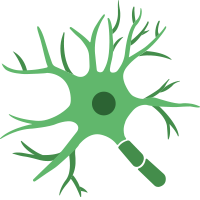
Neural Cell News
Neural Cell News is an online resource covering the latest research in neuroscience, neural stem cells, and neurological conditions.
FUDNC1-Dependent Mitophagy Ameliorate Motor Neuron Death in an Amyotrophic Lateral Sclerosis Mouse Model
[Neurobiology of Disease] The authors observed that FUNDC1 was significantly downregulated in the spinal cord tissues of SOD1G93A mice. FUNDC1 overexpression considerably improved locomotor activity and prolonged survival time in SOD1G93A mice.
NG2 Glia Protect Against Prion Neurotoxicity by Inhibiting Microglia-to-Neuron Prostaglandin E2 Signaling
[Nature Neuroscience] Loss of NG2 glia enhanced the biosynthesis of prostaglandin E2 (PGE2) by microglia, which augmented prion neurotoxicity through binding to the EP4 receptor.
Glioblastoma Disrupts Cortical Network Activity at Multiple Spatial and Temporal Scales
[Nature Communications] Researchers combined cellular and widefield imaging of calcium and glutamate fluorescent reporters in two glioblastoma mouse models with distinct synaptic microenvironments and infiltration profiles.
Micropeptide AF127577.4-ORF Hidden in a lncRNA Diminishes Glioblastoma Cell Proliferation via the Modulation of ERK2/METTL3 Interaction
[Scientific Reports] The authors identified and characterized a novel hidden micropeptide implicated in glioblastoma. They screened potential candidate lncRNAs by establishing a workflow involving ribosome-bound lncRNAs, publicly available MS/MS data, and prognosis-related lncRNAs.
Macroscopic Changes in Aquaporin-4 Underlie Blast Traumatic Brain Injury-Related Impairment in Glymphatic Function
[Brain] Scientists examined the expression and localization of AQP4 in human post-mortem frontal cortex and observed distinct laminar differences in AQP4 expression following blast exposure.
IRLAB Has Administered the First Dose in a Phase I Clinical Trial with the Drug Candidate IRL757
[IRLAB Therapeutics] IRLAB Therapeutics AB announced that dosing has been initiated in a Phase I study of the drug candidate IRL757. IRL757 has been shown in preclinical disease models to counteract apathy – a condition that impairs the quality of life for millions of people with Parkinson’s disease and other CNS diseases.
Single-Cell Patch-Clamp/Proteomics of Human Alzheimer’s Disease iPSC-Derived Excitatory Neurons versus Isogenic Wild-Type Controls Suggests Novel Causation and Therapeutic Targets
[Advanced Science] A new single-cell patch-clamp/proteomics platform termed scPatch-Proteomics was developed on single neurons generated from hiPSCs bearing an Alzheimer's disease genetic mutation.
Parkinson’s Patient Moves Freely Again after World-First Implant of Lab-Grown Cells Into His Brain
[STEM-PD] Researchers at Lund University have successfully implanted 7 million lab-grown brain cells into a patient to treat Parkinson's disease. Swedish resident Thomas Matsson was the first in the world to test the method about a year ago
CHD2 Regulates Neuron-Glioma Interactions in Pediatric Glioma
[Cancer Discovery] The authors reported that the chromatin remodeler CHD2 regulated neuron-glioma interactions in diffuse midline glioma (DMG) characterized by onco-histone H3.1K27M. Depletion of CHD2 in DMG cells compromised cell viability and neuron-to-glioma synaptic connections in vitro, neuron-induced proliferation of H3.1K27M DMG cells in vitro and in vivo, and extended the survival of H3.1K27M DMG-bearing mice.
Uncovering the Dynamics and Consequences of RNA Isoform Changes During Neuronal Differentiation
[Molecular Systems Biology] Investigators established an improved model for human neurogenesis in vitro that was amenable for systems-wide analyses of gene expression.
Inhibiting proBDNF To Mature BDNF Conversion Leads to ASD-Like Phenotypes In Vivo
[Molecular Psychiatry] Researchers generated a knock-in mouse line in which the conversion of pro-brain-derived neurotrophic factor (BDNF) to mature BDNF was attenuated. Mice showed reduced dendritic arborization, altered spines, and impaired synaptic transmission and plasticity in the hippocampus. They also exhibited autism spectrum disorder-like phenotypes, including stereotypical behaviors and deficits in social interaction.
Upregulated ECM Genes and Increased Synaptic Activity in Parkinson’s Human DA Neurons with PINK1/ PRKN Mutations
[npj Parkinson's Disease] The authors generated and differentiated dopamine and hippocampal neurons from human induced pluripotent stem cells derived from two patients with a double mutation in their PINK1 and PRKN genes and assessed their neurophysiology compared to two healthy controls.
Neural Cell News helps scientists keep pace with the latest research, reviews, and industry developments in neuroscience. Specific research topics include neural development and neuroregeneration, neural signaling related to cellular responses and behavior, and synaptic plasticity. Research into the diagnosis, progression, cellular characteristics, and treatment of brain diseases such as Parkinson’s, Multiple Sclerosis, Alzheimer’s, Amyotrophic Lateral Sclerosis and various brain cancers, as well as brain damage resulting from infection, trauma, stroke, seizures, and tumors, is also covered.

 Cancer Stem Cell News
Cancer Stem Cell News Cell Therapy News
Cell Therapy News Dermal Cell News
Dermal Cell News Endothelial Cell News
Endothelial Cell News ESC & iPSC News
ESC & iPSC News Extracellular Matrix News
Extracellular Matrix News Hematopoiesis News
Hematopoiesis News Hepatic Cell News
Hepatic Cell News Human Immunology News
Human Immunology News Immune Regulation News
Immune Regulation News
 Intestinal Cell News
Intestinal Cell News Mammary Cell News
Mammary Cell News Mesenchymal Cell News
Mesenchymal Cell News Muscle Cell News
Muscle Cell News Neural Cell News
Neural Cell News Organoid News
Organoid News Pancreatic Cell News
Pancreatic Cell News Prostate Cell News
Prostate Cell News Pulmonary Cell News
Pulmonary Cell News
